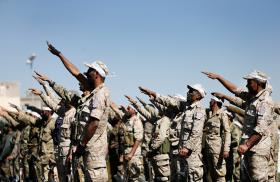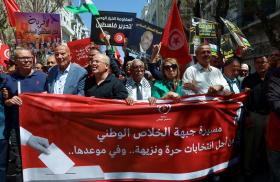- Policy Analysis
- PolicyWatch 3994
The Status of Syria’s Transition After Two Months
While the new government’s relative stability is a success, more details are needed on developing and implementing a national dialogue, a new constitution, and inclusivity measures.
Two months after Bashar al-Assad’s ouster, Syrian officials are preparing for a major international conference in Paris this week that will discuss their country’ political transition and reconstruction. To get a sense of where things stand today, foreign decisionmakers should focus on issues related to counterterrorism, accountability for Assad regime criminals, the future of Hezbollah and Iran’s local networks, Syria’s chemical weapons program, border arrangements with Israel, and the inclusivity of the political process.
The Transition
Initially, Syria’s new president—Ahmed al-Sharaa (aka Abu Muhammad al-Jolani), formerly head of the group Hayat Tahrir al-Sham (HTS)—announced that Muhammad al-Bashir would be prime minister of the caretaker government (slated to last until March 1), and that a national dialogue would take place to establish parameters for a new constitution. However, this dialogue has been delayed several times, allegedly due to capacity and logistical issues.
On January 29, Sharaa and other military leaders delivered what has been described as a series of victory speeches about Syria’s future. The most important speech was given by Col. Hassan Abdul Ghani, spokesman for the HTS Military Operations Department, who announced that all institutions related to the old regime—including the 2012 constitution, the People’s Assembly, the Baath Party, and all revolutionary factions (military, political, and civil)—would be dissolved and integrated into the new state institutions. This also meant that HTS is no longer officially an entity. How this announcement will be implemented, especially in relation to non-HTS factions, remains to be seen. More important, Ghani declared that Sharaa would assume the presidency during the next part of the transitional phase and would be authorized to form an interim legislative council, which will function until the drafting of a permanent constitution. In many ways, this formalizes the de facto situation since December 8, with remnants of HTS and its allies now completely in charge.
On January 30, Sharaa followed up with his own speech, stating, “We will work to form a comprehensive transitional government that expresses the diversity of Syria, its men, women, and youths, and that will undertake the work of building the institutions of the new Syria until we reach the stage of free and fair elections.” This was the first time he alluded to democratic elections. He also stated that he would announce preparatory committees to select a small legislative council for the transitional phase and to plan the national dialogue conference. Earlier today, he announced a seven-person preparatory committee for the national dialogue, though without setting a date on when they aim to complete their work. This will lead to the announcement of a constitutional declaration to serve as the legal reference for the rest of the transitional phase, which Sharaa has stated will take three to five years.
In short, the new government does appear to have a plan two-thirds of the way through the initial transition period. Yet its public declarations on these matters still lack specifics, so assessing how the process might play out is still difficult—a cause for concern in the many foreign capitals that want Syria’s transition to succeed.
Consolidating Local Control Again
Sharaa’s speech also laid out priorities for the coming period: (1) achieving civil peace and pursuing criminals from the previous regime; (2) completing the unification of all Syrian territory; (3) building strong state institutions based on competency and merit; and (4) establishing the foundations of a strong economy. In all these areas, the new government has generally moved the country in the right direction. Overall, post-Assad Syria has achieved a far higher degree of civil peace than many predicted two months ago. Authorities continue to investigate members of the previous regime, arrest members of Hezbollah networks, and interdict Captagon and weapons smuggling. This has led to greater cross-border clashes with Hezbollah-affiliated gangs. Such actions highlight opportunities for Washington, which has a keen interest in further degrading Hezbollah’s capabilities.
Only the second point—territorial unification—appears to be stuck, with continued fighting between the Syrian National Army (SNA), a Turkish proxy, and the U.S.-backed Syrian Democratic Forces in the northeast. Damascus and the SDF have been in back-channel negotiations to resolve the area’s future diplomatically, and neither has an interest in full-scale war. Yet the outcome of several issues remains uncertain, including border control, oil and gas resources, Kurdish/minority rights, the question of whether Syria will be federal or centralized in structure, the logistics of incorporating the SDF into the new Syrian military, and the future of the fight against the Islamic State and its 9,000 male prisoners who remain detained inside Syria. In addition, the SNA continues to attack the SDF, while multiple car bomb attacks have been attributed to SDF elements in Manbij.
In many ways, the past two months echo how HTS previously consolidated military control over northwest Syria and established the technocratic, civilian-led Syrian Salvation Government in 2017. Over the years, the group destroyed, forcibly took over, or merged with insurgent factions that opposed the Assad regime, then retained this dominance leading up to Assad’s ouster. In December 2021, HTS established formal command and control over its territory by establishing a military college that better integrated all of the area’s factions. Meanwhile, the Salvation Government sought to coopt independent local councils, some of them previously affiliated with the rival “Syrian Interim Government,” which helped govern various locales after the 2011 revolution.
Since Assad’s fall, the new caretaker government has more or less followed this model in areas it now controls, apart from northern Aleppo province, Raqqa province, eastern Deir al-Zour province, and Hasaka province, which remain under SNA or SDF control. HTS has coopted the Assad regime’s state apparatus and implemented a governance model very similar to what it employed in the northwest under the Salvation Government, but on a grander scale—primarily through engagement with local notables, religious leaders, tribal sheikhs, and businessmen, whom it consults on whatever local issues might need resolution. The new government’s numerous meetings throughout the country have primarily focused on services, not on the transition or constitution. The process has also been inherently biased against women, in part because most local notables are men (women have participated in the meetings, just not at the same scale as men).
Security and Economic Measures
The caretaker government has held a series of meetings with leaders of various anti-regime insurgent factions in an attempt to bring them all under the fold of a new Syrian military and Ministry of Defense, led by Murhaf Abu Qasra (Abu Hassan al-Hamwi), former head of HTS military operations. So far, around a hundred armed factions have joined the Defense Ministry, including the U.S.-backed Syrian Free Army, based in al-Tanf garrison and now Tadmur after the regime’s fall. Yet some holdouts remain, including the notorious former rebel Ahmad al-Awda and various Druze military factions. Moreover, some of the new military officers and governorate commanders—who include SNA leaders and foreign fighters—are U.S.-designated terrorists.
As for the economic component, the easing of sanctions and greater diplomatic engagement have provided an initial foundation for recovery (e.g., the new government conducted 330 diplomatic engagements between the regime’s fall and February 11). Moreover, the exchange rate for the Syrian pound to the U.S. dollar has improved, down to around 9,000 to 1 after peaking at around 15,000 to 1. While this is still not optimal, it is heading in the right direction, especially as more countries seek to invest in reconstruction—most notably Turkey and the Gulf states, but also likely Jordan, the United Kingdom, France, Ukraine, Italy, Pakistan, and Malaysia, among others. Yet the road ahead remains long due to Syria’s massive poverty and lack of food, electricity, and energy resources—illustrating the need to further ease sanctions and carve out new general licenses to ease these burdens.
Policy Implications
From a U.S. policy perspective, Syria’s relative stability thus far is a success. However, a great deal more must be done—especially in the transition’s next phase—regarding the national dialogue, the constitution, and measures to include elements who are not HTS loyalists or allies.
Regarding the national dialogue, the UN can play a role by helping authorities overcome the convening and logistical issues that have undermined efforts to plan it. The main concern is not that the new government will resort to terrorist activity at home or abroad, but rather that the new leaders might slow-roll into soft authoritarianism.
For its part, the Trump administration should build on the Biden administration’s initial engagement to ensure that the fight against the Islamic State continues. Reopening the Syrian embassy in Washington could provide greater opportunities for engagement on a variety of issues, with a focus on the following:
- Phasing the SDF’s integration into the new Syrian military and not forcing it haphazardly, which could undermine stability.
- Providing useful intelligence to the new authorities as needed. In January, for example, U.S. intelligence helped Damascus break up an IS plot to bomb the Sayyeda Zainab shrine. Washington could also provide information on Hezbollah drug and weapon smuggling networks.
- Pushing the government to destroy all remaining chemical weapons, a process that will hopefully accelerate now that the Organisation for the Prohibition of Chemical Weapons has begun engaging with the new government in the past week.
- Solidifying the 1974 Israel-Syria border agreement as called for by the caretaker government. This includes asking the UN Disengagement Observer Force (UNDOF) to reassert its presence in the border deconfliction zone.
- Continuing to call for an inclusive transition process.
- Articulating to the new government that meeting U.S. benchmarks will mean greater sanctions relief.
Without continued engagement, a vacuum could emerge in Syria, and adversaries such as Russia could quickly exploit it. At the very least, Washington should confer with its partners to make sure their policies align, ensuring that the transition continues to head in the right direction even if it moves slowly.
Aaron Y. Zelin is the Levy Senior Fellow at The Washington Institute and author of The Age of Political Jihadism: A Study of Hayat Tahrir al-Sham.



